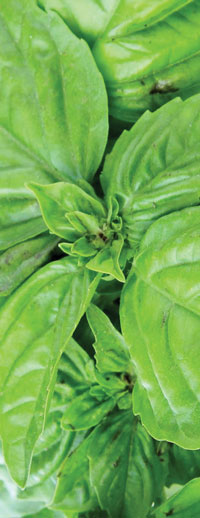Season:
Spring through summer
Nutrition Facts:
A four teaspoon serving of fresh basil has 20 mg of potassium and 0 calories. Basil has a warm, spicy smell and a pungent flavor, similar to that of licorice and cloves. The most common variety is sweet basil. Other popular varieties include Italian, lemon, purple, Thai and dwarf basil.
Uses:
The flavor of many garden vegetables is enhanced by adding fresh basil. It adds zest to summer squash, eggplant, potatoes, cabbage, cauliflower and spinach. The most common use is in tomato recipes and is the main ingredient in pesto
Storage:
Basil may be harvested anytime and used fresh. To dry basil leaves, cut the stalks 6 inches above the ground. Strip the leaves and dry in a dehydrator or place on a screen and dry in a dark, well ventilated room. Basil can also be dried by hanging upside down in a well ventilated space, out of the sun. Store dried leaves in an air-tight container. Leaves can also be frozen. Frozen or dried basil should be used within a year
Growing:
Basil is easy to grow from seed. Start seeds indoors 4-6 weeks before the last frost. It can grow 1 foot tall in a garden but is often grown indoors in containers. Basil plants require a lot of sunlight
 Buying Kentucky Proud is easy. Look for the label at your grocery store, farmers' market, or roadside stand.
Buying Kentucky Proud is easy. Look for the label at your grocery store, farmers' market, or roadside stand.


